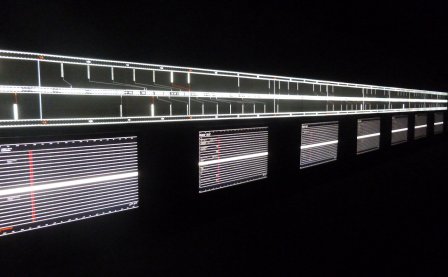"Caution! This CD contains specific waveform, impulse and burst data that perform a response test for loudspeakers and headphones. High volume listening of the last track may cause damage to equipment and eardrums."
So reads the disclaimer on the sleeve of Ryoji Ikeda’s new batch of auditory hallucinations entitled Test Pattern. Seems while Tipper Gore was getting her panties up in a bunch slapping Parental Advisory stickers on the albums of any rapper who would utter such profanities as ‘bitch this’ or ‘hoe that,’ the real threat lay in the prospect of conceptual sound artists damaging valuable electronics and deafening our nation’s experimental music fans. A similar warning graced the cover of Dataplex, Ikeda's 2005 release, with the one notable exception being the promise that playing it wouldn’t result in the demise of your CD player and/or ears. Dataplex was the first readily available document of Ikeda’s Datamatics series, a multimedia project dealing with the artist’s ongoing obsession with the sheer overload of data in the modern world.
Test Pattern is the second release in the series, and its techniques are part continuation and part departure from the material on Dataplex. As a pure auditory experience, it may be a step down from Dataplex, but what it lacks in sonics it makes up for in conceptual gold. Moreso than its predecessor, Test Pattern showcases Ikeda’s ability to derive meaning out of the most stripped-down sounds. A veritable Morse code awaits the listener on Test Pattern, with every sound dissected to its subatomic particles. You’ll hear tones, frequencies, blips and bleeps, but never notes, never melodies. With such an amusically stacked deck, you’d think it would be impossible to create anything even marginally interesting; for Ikeda, however — who, like Satie or Feldman, thrives on the austere — it’s a snap.
The real beauty of Ikeda’s work lies in its ability to provoke some of the deepest thoughts you’ve had on the nature of sound and, even, reality. I still remember sitting in my friend’s college dorm on an early psilocybin-fueled journey, listening to Ikeda’s 2001 release, Matrix; the disc consisted of one long sine wave whose properties were such that, in an enclosed room, the sound would change depending on your ears’ relation to the speakers. Climbing on top of furniture and seeking new aural vantage points, all involved were dramatically moving their heads and bodies in an attempt to modulate the tone and thus control it, a truly novel moment in my progression of understanding/having my mind blown about sound. That is the essence of Ryoji Ikeda: he throws everything you knew about reality out the window and thrusts open those rusted doors of perception.
In addition to the highly conceptual vein that runs through Ikeda’s oeuvre, an obsession with process scampers neatly nearby. Test Pattern’s labyrinthine levels of process are absolutely dizzying. Ikeda takes (mostly visual) media and, using a “cross platform conversion system,” turns these images or videos into barcodes, which are then broken down into raw mathematical data. In a gallery setting, the barcodes derived from this conversion and featured on the cover of the album are projected as flickering images. That raw data is then converted to the sounds you hear on Test Pattern. This final step is, in a sense, the only truly human one, in which Ikeda takes the encoded data and sculpts it, transforming it into something both musical and non-musical — something that is at times wedded to the dance floor, at others awash in a sea of digital cacophony. "Test Pattern #0001" begins like the old emergency broadcast signal for which the album is named, before separating into isolated shocks, which quite marvelously recapture the sensation of receiving acupuncture. And where "Test Pattern #0011" offers the listener slightly undulating subliminal brainwaves, "Test Pattern #0100" could be a minimalist take on a Dirty South Crunk anthem.
In fact, because the sounds on Test Pattern are separated from their original sources, any of these tracks could be quite literally anything at all. Perhaps "Test Pattern #0011" is the rerouted binary code of a Lil’ Jon song; maybe "Test Pattern #1111" is a picture of a kitten with some badly translated caption; and I’d have no idea if "Test Pattern #1110" weren’t a video of Hitler sieg-heiling. However, due to the separation of these tracks from their ur-signifiers, my separate emotions regarding a track and its source would most likely remain unchanged. It’s a fascinating statement, anyway, on how this massive flow of data that is constantly being uploaded, downloaded, converted, and sent around the world at the click of a button seems to be divorcing everything from its inherent meaning. This process is bound to leave one feeling confused or dehumanized. But by restructuring fragmented syntaxes into something that is meaningful again, Ikeda shows a way to regain the power of our own lost meanings, and provides a fine example of how to go into the future not as unwitting victims of exponentially increasingly novelty, but as intermediaries of information, whose new salvation will lie in decoding and re-humanizing the ever-expanding data flow.
More about: Ryoji Ikeda




